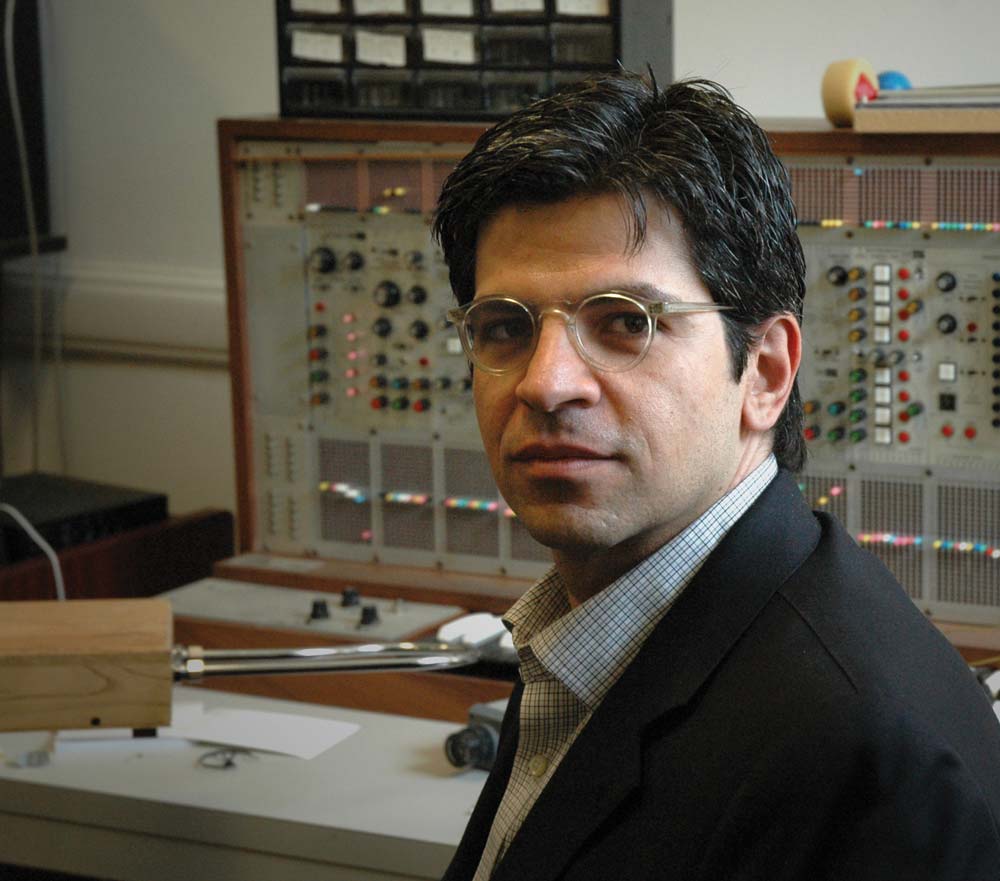Music for the Silver Screen
How a film score tells the emotional story of a movie

Yiorgos Vassilandonakis is something of a renaissance man. Born in Greece, he started out studying music theory and classical guitar, eventually developing a diverse portfolio including opera as well as scores for theater, television and independent films like Angelmaker (Berman, 1998) and The Flyer (Green, 2006) before coming to UVA as a visiting assistant professor in the McIntire Department of Music.
An hour with the composer offers a rare glimpse into the inner workings of Hollywood; the course he offers is a film buff’s dream. The students work on everything from scoring a film using only the “original” tools—a stopwatch and conversion chart—to composing for car commercials with the latest technology. The class gives students an aesthetic sense of the history of filmmaking and a real shot at entering a tough market. “There are several ways to get into this field,” he explains. “You can either be an assistant to a composer or you can get your start scoring commercials and technical films, and then move into television and films.”
As with any artistic endeavor, it’s a tough climb. But Vassilandonakis adds the hopeful note that changes in the industry have created more opportunities for people to get into films. “It used to be that every studio had its own orchestra. Now, every film is an independent film, and the big studios act more like distributors. That means there are more directors out there hiring independent composers, and advances in technology have made it far cheaper to create short films.”
Vassilandonakis’ insight can help even the tone-deaf better appreciate how music is used in film. “One very important distinction,” he notes, “is between the songs and the score.”
Songs are used in films to evoke a sense of the period or trigger various associations. For example, a Buddy Holly song might conjure the early days of rock ’n’ roll.
The score is designed by the composer to create and enhance the emotions, plot, themes and tensions of the film. “The best film music works without us being aware of it,” Vassilandonakis says. “You don’t want the music to seem like a separate element. It should be seamless. There are no hard and fast rules for creating a score; it’s both a very technical and intuitive process.”
Yet there are some general rules and techniques that are familiar to film and television audiences. “The most obvious use of music is mimetic,” Vassilandonakis says. He cites the cartoon Tom and Jerry as an example. “When Tom runs up the stairs, you hear dink, dink, dink, dink, dink. This is usually too much for film. You want the music to contribute to the narrative, but not be too obvious.”
Fast, loud music is often associated with action in movies. Slow, swelling music can evoke a sense of drama. “You can also use music in unexpected ways,” Vassilandonakis says. “For instance, in the movie Platoon, there is the dramatic scene where a character is being shot. It’s very violent. You would expect the typical Hollywood movie to have fast-paced, aggressive music here. But instead they used Samuel Barber’s Adagio for Strings—it’s amazing and very unexpected.”
Another tactic is to use music to establish something in the story before it actually happens. “For instance, if you watch the movie Psycho with the sound off, the opening scenes with the woman driving seem very normal; but if you turn the sound on, you can hear that the music in the film is being used to establish that something is off.”
Having mastered the process of scoring music for film, Vassilandonakis is now flipping the process on its head by commissioning a director to create a film based on a score he has already composed. “I believe this project, as it is conceived now, to be a first,” says Vassilandonakis. “There have been many experimentations with music and film in non-traditional settings, but this particular concept is quite different in that it redefines the dynamic between the elements and the creative process itself.”
Vassilandonakis’ Playlist

Most influential film scores:
- The Adventures of Robin Hood (1938), Composer: Erich Wolfgang Korngold
- Psycho (1960), Composer: Bernard Herrmann
- Lawrence of Arabia (1962), Composer: Maurice Jarre
- 8 1/2 (1963), Composer: Nino Rota
- Planet of the Apes (1968), Composer: Jerry Goldsmith
- Star Wars (Episode IV) (1977), Composer: John Williams
- Altered States (1980), Composer: John Corigliano
- Blade Runner (1982), Composer: Vangelis
- Ran (1985), Composer: Toru Takemitsu
- The Mission (1986), Composer: Ennio Morricone
Songs for a romantic dinner:
- “I Want You” by Bob Dylan
- “Something Stupid” by Frank and Nancy Sinatra
- “These Foolish Things” by Roxy Music
- “Interlude” by Siouxsie & Morrissey
- “Fade Into You” by Mazzy Star
Songs to get people to dance:
- “Rock the Casbah” by The Clash
- “Hung Up” by Madonna
- “Beat It” by Michael Jackson
Wedding songs:
- “Wedding Song” by Bob Dylan
- “Somewhere” (from West Side Story) Cover by Tom Waits
- “Perfect Day” by Lou Reed
LISTEN
A clip from The Flyer film score.